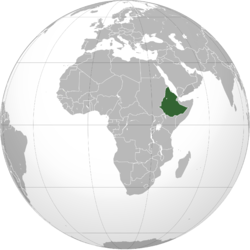People's Democratic Republic of Ethiopia
| People's Democratic Republic of Ethiopia | ||||||||||
| የኢትዮጵያ ሕዝባዊ ዲሞክራሲያዊ ሪፐብሊክ ye-Ītyōṗṗyā Həzbāwī Dīmōkrāsīyāwī Rīpeblīk |
||||||||||
| Satellite state of the Soviet Union | ||||||||||
|
||||||||||
|
||||||||||
|
Anthem Ītyoṗya, Ītyoṗya, Ītyoṗya, qidä mī ኢትዮጵያ, ኢትዮጵያ, ኢትዮጵያ ቂዳ ሚ "Ethiopia, Ethiopia, Ethiopia be first" |
||||||||||
|
The People's Democratic Republic of Ethiopia in 1991.
|
||||||||||
| Capital | Addis Ababa | |||||||||
| Languages | Amharic | |||||||||
| Government | Marxist-Leninist one-party state | |||||||||
| General Secretary | ||||||||||
| • | 1987–1991 | Mengistu Haile Mariam | ||||||||
| President | ||||||||||
| • | 1987–1991 | Mengistu Haile Mariam | ||||||||
| • | 1991 | Tesfaye Gebre Kidan | ||||||||
| Prime Minister | ||||||||||
| • | 1987–1989 | Fikre Selassie Wogderess | ||||||||
| • | 1989–1991 | Hailu Yimenu | ||||||||
| • | 1991 | Tesfaye Dinka | ||||||||
| Legislature | Shengo | |||||||||
| Historical era | Cold War | |||||||||
| • | Constitution adopted | 22 February 1987 | ||||||||
| • | Ethiopian Civil War | 28 May 1991 | ||||||||
| Area | ||||||||||
| • | 1987 | 1,221,900 km² (471,778 sq mi) | ||||||||
| Population | ||||||||||
| • | 1987 est. | 46,706,229 | ||||||||
| Density | 38.2 /km² (99 /sq mi) | |||||||||
| • | 1990 est. | 51,666,622 | ||||||||
| Density | 42.3 /km² (109.5 /sq mi) | |||||||||
| Currency | Ethiopian birr (ETB) | |||||||||
| Calling code | +251 | |||||||||
|
||||||||||
| Today part of |
|
|||||||||
The People's Democratic Republic of Ethiopia (PDRE) was the official name of Ethiopia from 1987 to 1991, as established by the Communist government of Mengistu Haile Mariam and the Workers' Party of Ethiopia (WPE). Its creation led to the dissolution of the Derg, the military junta formerly in charge of the country. A Marxist-Leninist one-party state with the WPE as supreme authority took its place, though the WPE's leadership was dominated by the surviving members of the Derg.
After five years of preparation, a socialist state was officially proclaimed in 1984, and the WPE was formed as the country's only legal party. It was a Marxist-Leninist vanguard party modeled on its counterparts in Europe. The PDRE officially came into existence on 22 February 1987, three weeks after the national referendum that approved the 1987 constitution, although the Derg remained in power as late as September, long after the 14 June general election that elected the members of the National Shengo (the legislature).
The WPE was officially granted a monopoly of power as the "leading force in the state and society." The government was highly centralized and for all intents and purposes acted as merely a transmission belt for the party.
Throughout the PDRE's brief life, its authority was challenged not only by armed militants in Eritrea, which had been annexed to Ethiopia several decades earlier, but also by internal resistance groups, foremost of which was the Tigrayan Peoples' Liberation Front. The PDRE came to an end in May 1991, when Mengistu fled Ethiopia and military units of the Ethiopian People's Revolutionary Democratic Front entered Addis Ababa.
...
Wikipedia



